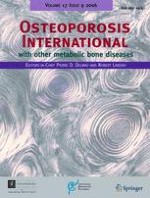01-09-2006 | Original Article
Device-specific thresholds to diagnose osteoporosis at the proximal femur: an approach to interpreting peripheral bone measurements in clinical practice
Published in: Osteoporosis International | Issue 9/2006
Login to get accessAbstract
Introduction
A single T score criterion cannot be universally applied to different peripheral bone measurement devices, since measurements in an identical population result in a tenfold difference in the prevalence of osteoporosis. The use of peripheral devices is increasing in clinical practice, despite the difficulties in interpreting results. We propose the use of two thresholds, which have either 95% sensitivity or 95% specificity, to identify (1) individuals who require treatment or (2) individuals who require no treatment, both based on a peripheral measurement alone, or (3) individuals who require additional central densitometry measurements.
Methods
We recruited 500 postmenopausal women, 100 premenopausal women and 279 women with proximal femoral, vertebral, distal forearm or proximal humeral fractures. All subjects underwent dual energy X-ray absorptiometry (DXA) measurements of the lumbar spine, total hip and distal forearm, quantitative computed tomography (QCT) of the distal forearm and quantitative ultrasound (QUS) of the heel (four devices), finger (two devices), radius and metatarsal. We identified the threshold for each device that identified women without osteoporosis with the same sensitivity (upper threshold set at 95%) as total hip DXA and women with osteoporosis with the same specificity (lower threshold set at 95%) as total hip DXA. Individuals between the two thresholds required additional examination by central densitometry.
Results
The correlation between devices varied from 0.173 (QUS finger) to 0.686 (DXA forearm) compared with total hip DXA (P<0.0001). The area under the curve (AUC) between devices varied from 0.604 (QUS finger) to 0.896 (DXA forearm) compared with total hip DXA (P<0.0001). In a population-based cohort (prevalence of osteoporosis 9.8%) the threshold approach appropriately identified between 26% (QUS heel) and 68% (DXA forearm) of subjects in whom a treatment decision could be made without additional central DXA with 95% certainty. In a fracture cohort (prevalence of osteoporosis 36%) between 16% (QUS finger) and 37% (QCT forearm) of subjects were appropriately identified.
Conclusion
The threshold approach to interpreting peripheral bone measurements enables a substantial number of individuals with either normal bone mineral density (BMD) or osteoporosis to be selected and treated appropriately.





